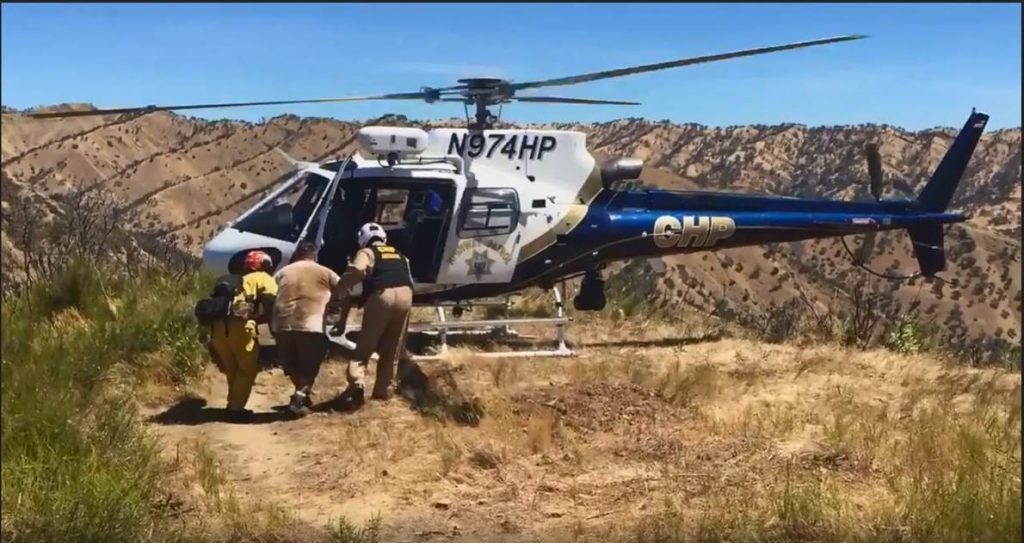Training Exercise Turns into Real Time Rescue
Chris Brunner, June 26, 2017

Dr. Payne, on left in yellow turnouts, helps lift the hiker into the helicopter. (Photo by: Nancy Maty, Solano County Search and Rescue)
Be prepared for your next hiking expedition – Take precautions against heat exhaustion and heat stroke
The beautiful and popular hiking site of Stebbins Cold Canyon Reserve nestled between Napa and Solano counties boasts the Blue Ridge Loop trail with its panoramic views of Lake Berryessa and the surrounding mountains. The reserve is part of the UC Davis Natural Reserve System, and is one of the most popular hiking spots in northern California. The trail has become so popular in fact that calls for rescue of sick and injured hikers have climbed dramatically. While rescues commonly involve lost hikers, sprained ankles or broken legs, during the summer by far the most common emergency call relates to heat stroke or heat exhaustion.
A day on the trail turns into rescue
The problem with hiker rescue has become so acute that a multi-agency public safety outreach and training drill was conducted on Saturday June 17 to help raise public awareness about trail safety. Working in cooperation with Jeffrey Clary from the UC Natural Reserve System, members of the Solano County Office of Emergency Services Search and Rescue Team and the local Vacaville Fire Protection District set up information tents at the trail head to hand out water and maps containing trail safety information.
As part of the training drill, a four-man OES-Fire Service team was sent up the trail, to practice communication operations as they enacted a real rescue. The drill turned into a real life rescue however when the team reached the ridge and encountered a hiker who had passed out due to the heat and then upon regaining consciousness had vomited numerous times. The hiker was unsteady on his feet, weak and unsure of his ability to hike back down the trail. Reporting their findings back to the base, a California Highway Patrol helicopter was flown in to retrieve the hiker, who was set down at the Canyon Creek Resort for further evaluation and treatment.
“This trail can be dangerous, particularly in the summer and hikers need to review their safety precautions.” says Battalion Chief Dennis Fogleman of the Vacaville Fire Protection District.
Preparation – Preparation – Preparation
Hikers using the trail in the summer heat should carry a minimum of two liters of water per person. In addition, the hike should start early enough to complete the 5-mile, 3-hour loop before the temperature reaches 80° – 85° F. During the summer this often means starting at the trail head no later than 9 am, earlier on some days. Hikers can use weather forecast sites like Weather Underground to help decide on a safe time-frame to start and complete the trail. A trail map with trail safety advice was created by OES and the Vacaville Fire District. Reviewing those precautions may even save hikers some money, since depending on which mutual aid units are used, there may be charges for the rescue.
Dr. Michael Payne, is part of the WIFSS Animals in Disaster Preparedness team, and a volunteer firefighter with the Vacaville Fire Protection District. He served as rescue team leader for the Cold Canyon drill. WIFSS awareness level courses provide tools to protect, respond to, and recover from the consequences of disasters involving animals in rural communities. Dr. Payne is keenly aware of the need for preparation, whether the focus is human or animal rescue. An avid hiker himself, he believes hiking is great exercise and great fun. Mike offers this advice to those about to hit the trail, “A little bit of preparation goes a long way.”
For more information on disaster preparedness see materials on WIFSS website.
